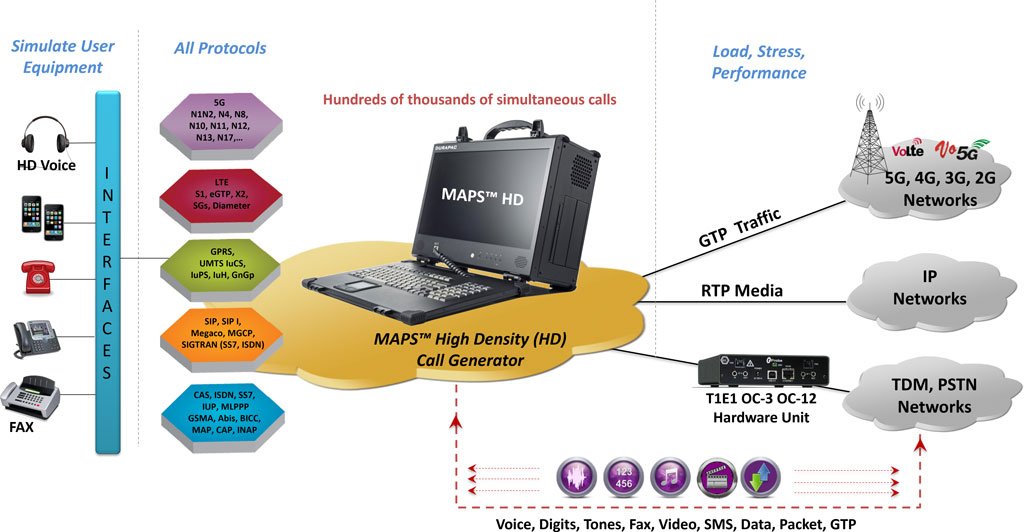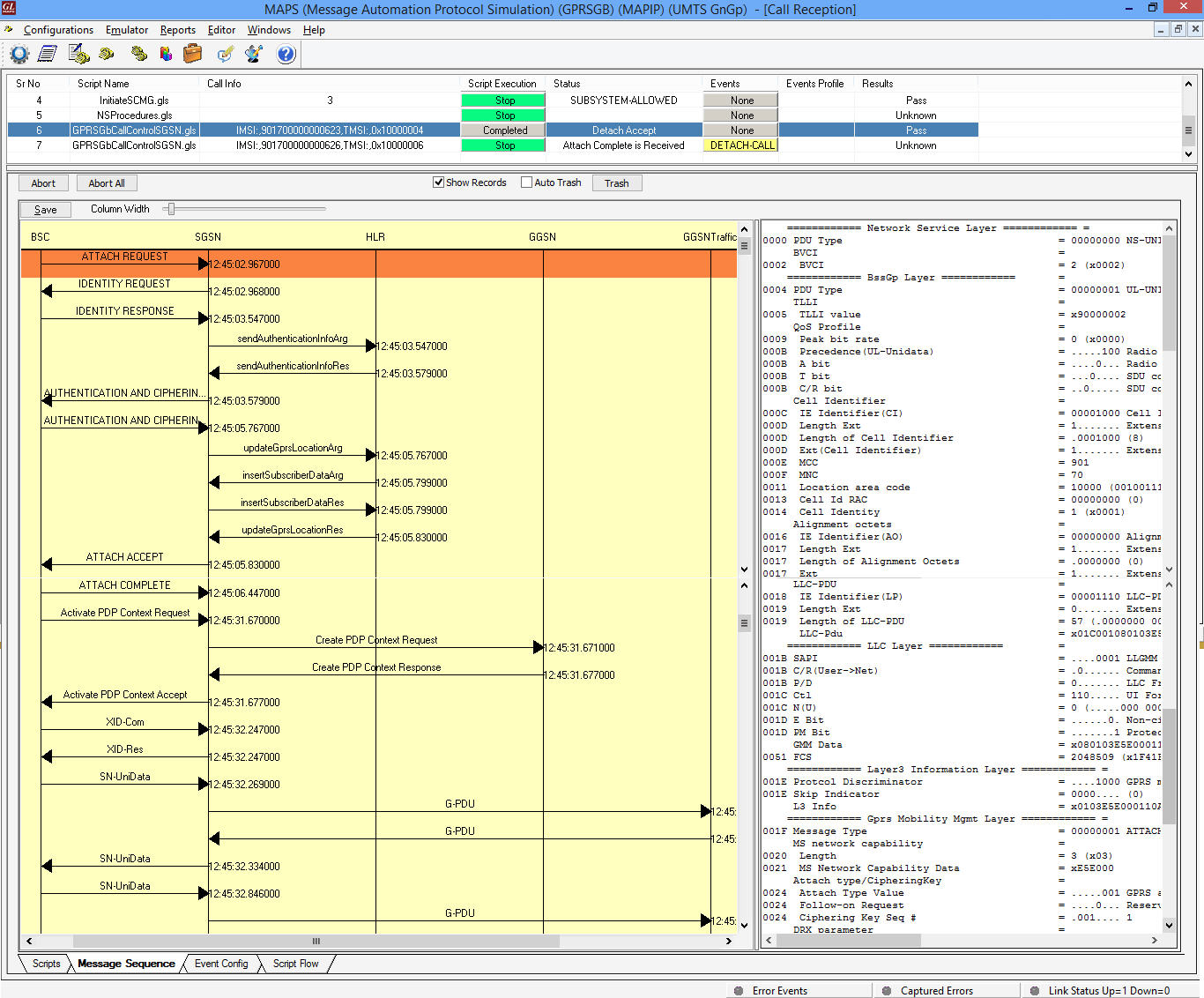Traffic Simulation across IP, Analog, TDM, and Wireless Networks with MAPS™
Overview
As traffic intensity increases, network elements (including switches and transmission) can impart various impairments such as errors, excessive delay, congestion, blocking, loss, and degraded quality. Simulating traffic can be valuable to characterize the impairment as a function of traffic intensity and traffic types (e.g. Voice, Fax, Data, & Video).
Message Automation and Protocol Simulation (MAPS™) is a multi-protocol, multi-technology platform used for signaling and traffic generation for a vast array of communication protocols covering IP, Analog, TDM, and Wireless networks. MAPS™ can be used to test legacy networks (which use conventional signaling such as CAS, SS7, ISDN, PPP,…), newer generation IP networks (such as SIP, MGCP, MEGACO, SIGTRAN, Diameter…), and also the Wireless networks (which use GSM, UMTS, LTE and Diameter signaling).
With MAPS™ Client-Server application, MAPS™ supports a Command Line Interface (CLI) such as the Python, Java, TCL and other scripting tools, to provide the capability of remote operation, automation, and multi-site connectivity. User can remotely perform all functions such as start testbed setup, load scripts and profiles, apply user events such as send digits/file/tones, detect digits/file/tones, dial, originate call, terminate call, start and stop traffic and so on.
GL’s MAPS™ HD is a High Density 1U network appliance that is capable of high call intensity (hundreds of calls/sec) and high volume of sustained calls (tens of thousands of simultaneous calls/1U platform) for a vast array of communication protocols covering IP and Wireless networks. MAPS™ HD network appliance is designed to easily achieve up to 20,000 endpoints per appliance (5000 per port). This requires GL’s RTP HD traffic generation capability (PKS109) and specialized 1U rack system with integrated HD NIC ( w/ 4x 1 GigE. Or 2x 10 GigE).
For more details, visit Signaling and Traffic Simulator webpage.
| Traffic Type | License | |
|---|---|---|
GTP Mobile Traffic Simulation |
|
ETH100 |
|
ETH101 | |
|
(requires optional license-contact GL) | |
|
ETH102 | |
|
ETH103 | |
RTP Traffic Simulation |
All Voice Codecs supported including -
|
PKS102 |
|
PKS106 | |
|
PKS108 | |
|
PKS200, and PKS211 | |
|
PKS109 | |
SMS Traffic Simulation |
|
|
TDM Traffic Simulation |
|
xx610, xx620 |
|
|
xxFT0 |
|
XX646 |
Voice, Digits, Tones
With the purchase of additional license (xx610, xx620), MAPS™ supports transmission, detection and capture of DTMF/MF digits, voice files, single /dual tone over established calls on TDM and Analog networks. The volume of calls can vary from few hundreds to thousands of calls depending on the T1 E1 or Analog platform of choice.
These features are applicable for MAPS™ ISDN, MAPS™ SS7, MAPS™ GSM A, MAPS™ CAS, and MAPS™ FXO FXS applications only.
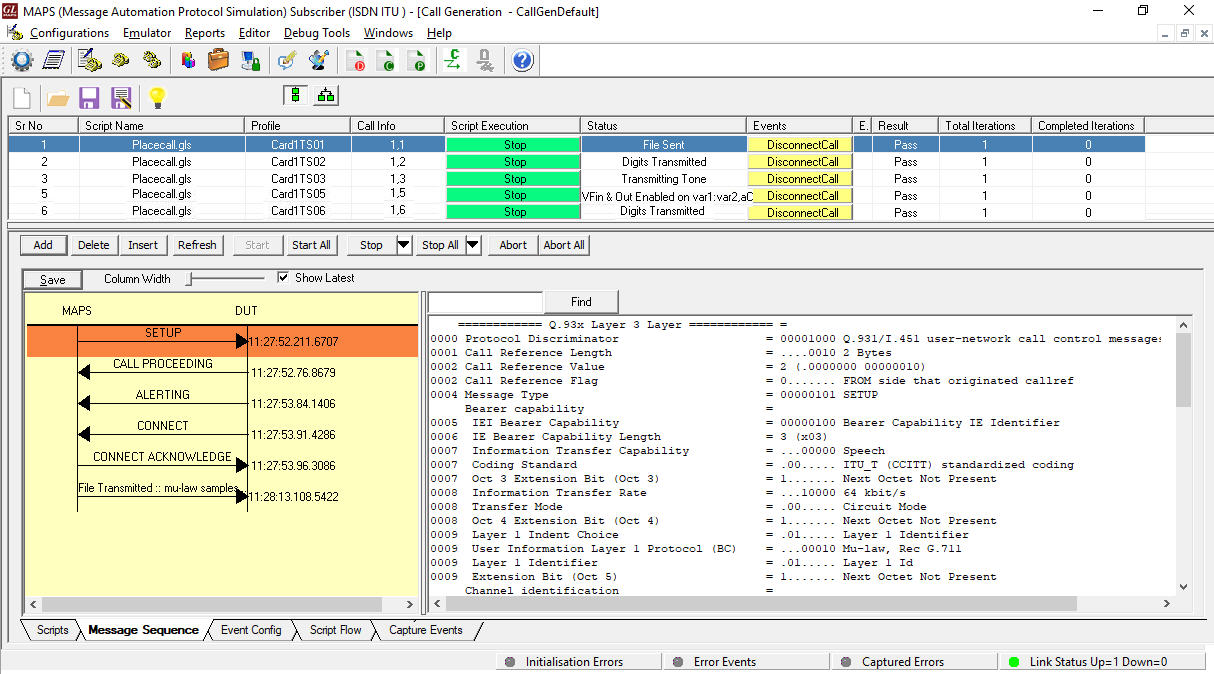
TRAU GSM Traffic
For GSM, TRAU (Transcoder Rate Adapter Unit) traffic simulation (xx646) is included with options to create, monitor, and terminate TRAU GSM traffic sessions supporting transmit/receive DTMF digits, files, and tones over established GSM calls. TRAU traffic simulation is applicable for MAPS™ GSM Abis application only.

Fax Simulation over T1 E1
Fax Simulator (XXFT0) is capable of transmitting and receiving bulk fax over many T1 E1 timeslots or through two-wire FXO and FXS lines. The software can emulate many "virtual fax machines" - transmitter as well as receiver. All variations of T.30 fax protocol is supported such as page size, resolution, min & max data rate, and codec type - including high speed fax such as V.34. This application works with MAPS™ TDM products simulating complete real-time single and bulk (100's) fax calls.
GL also supports FaxScan™ (fax decoder/demodulator) software that processes 2-Wire or 4-Wire captures and analyzes voiceband traffic files for fax traffic. The application operates either stand-alone from a batch file or as part of the GL's VoiceBand Analysis application to produce decoded fax image TIFF files and other transmission information.
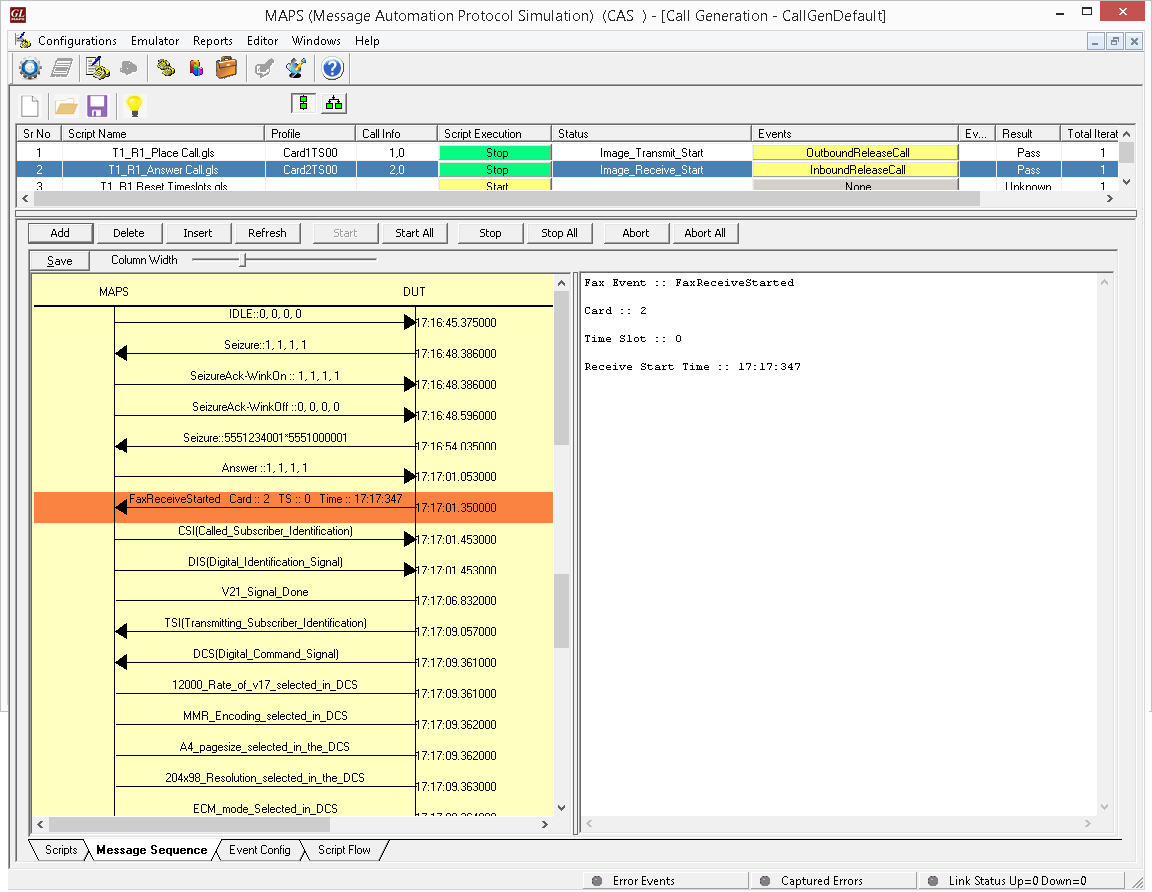
SMS Traffic
MAPS™ also supports sending and receiving SMS (Short Message Service) using signaling channel simultaneously with other voice and data services over a GSM, UMTS, or MAP interfaces. MAPS™ has the ability to push / pull Short Messages over the network as if sent by thousands of mobile phones (Short Message Mobile Originated (SMS-MO)). MAPS™ can also transmit a Short Message to a mobile phone (Short Message Mobile Terminated (SMS-MT)). The short message service testing is available on the GSM, UMTS, and MAP interfaces. GL’s 2G, & 3G Wireless Lab setup supports end-to-end SMS calls simulation in Circuit Switch (CS) network.
This feature is supported in MAPS™ GSM A over IP, MAPS™ MAP, and MAPS™ UMTS IuCS & IuH applications.
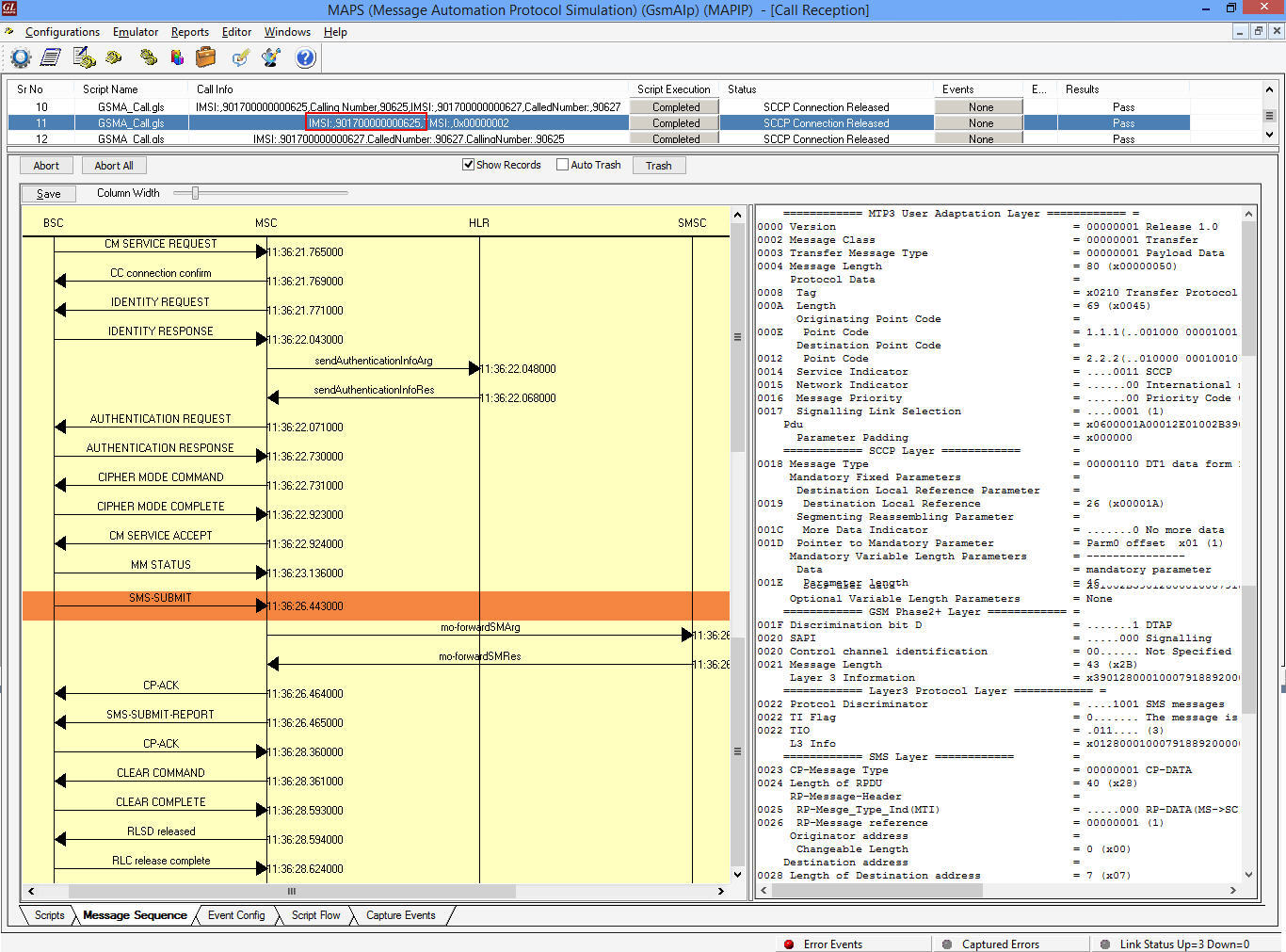
IVR Test Solution
MAPS™ provides a unique architecture for multi-interface, multi-protocol simulation, which make it suitable for testing any core network, access network and inter-operability functions. VQuad™ Probe HD is an all-in-one self-contained hardware supporting multiple physical interfaces for connecting to practically any end point in wired or wireless network while automatically performing end-to-end voice and data testing over any network.
Using ready-to-use scripting with these products it is possible to automate the IVR testing process. GL's IVR test platforms can detect user-defined digits, send DTMF digits in response to voice prompts, tones, and play/record voice files, perform speech-to-text transcription, and analyze transcribed text for correctness, using a simple setup and automate the whole process through scripts.
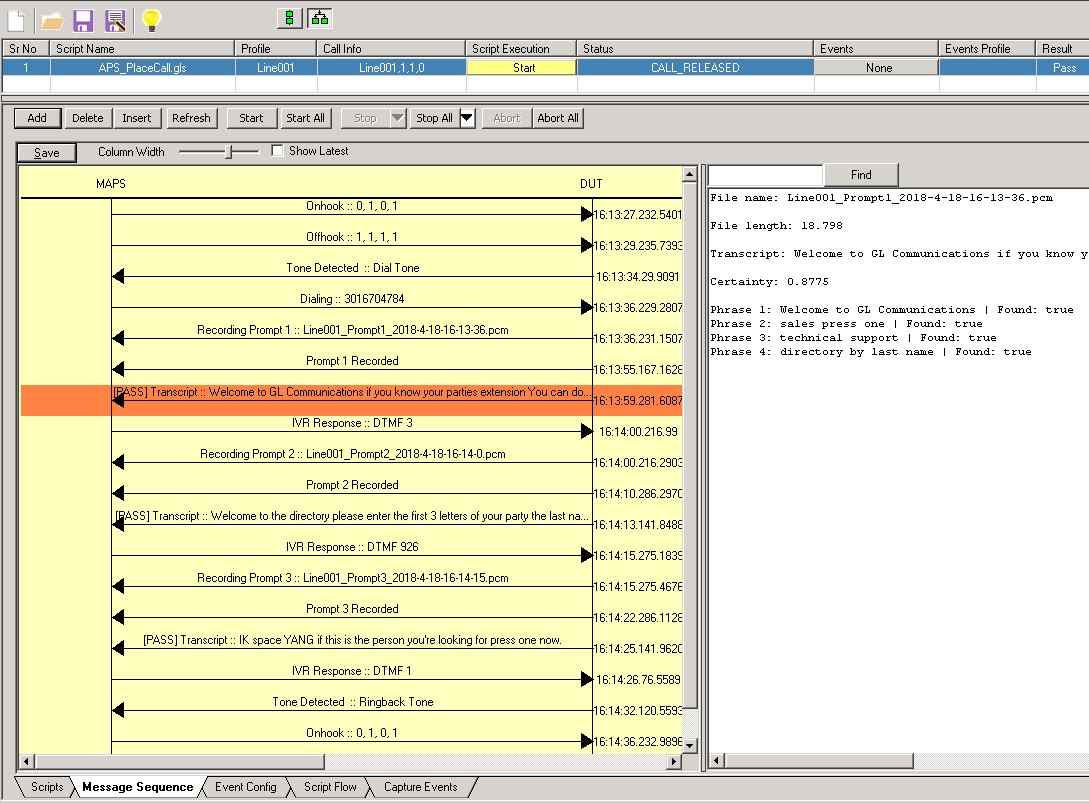 |
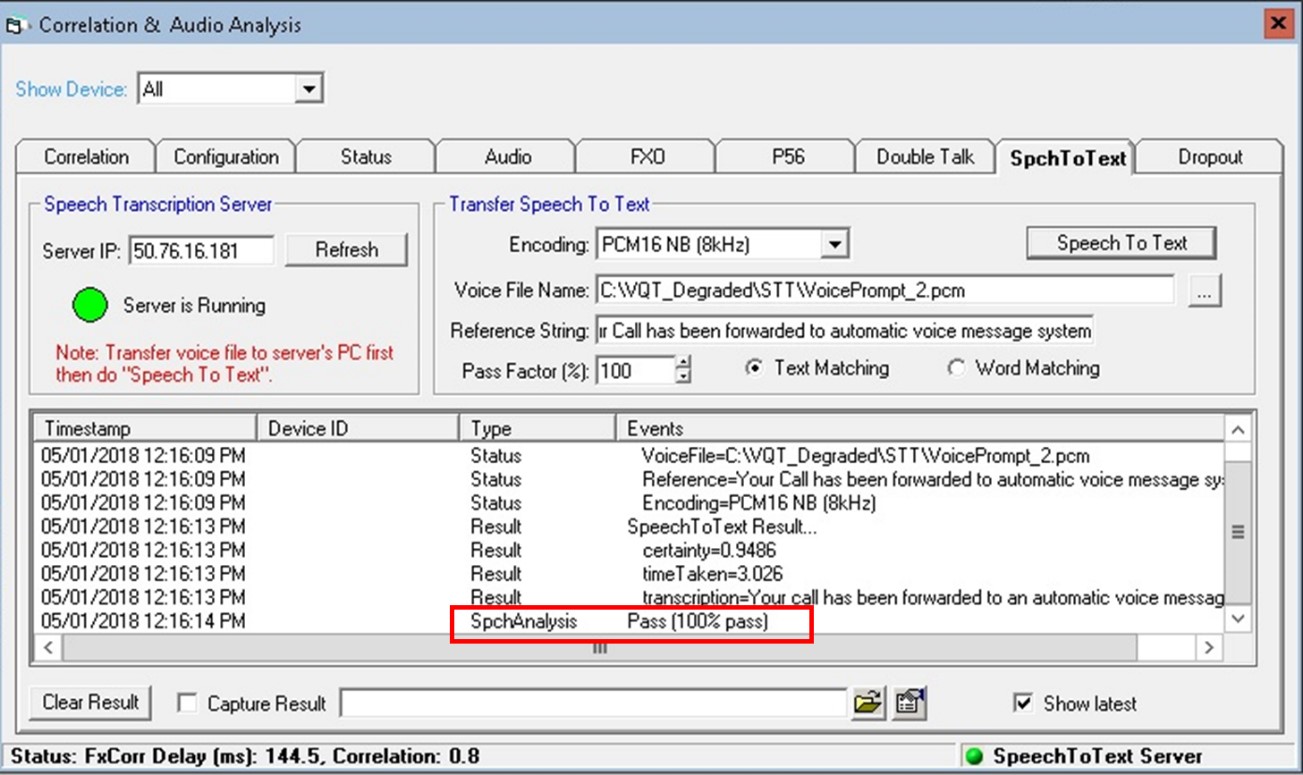 |
User Plane Traffic Simulation for 5G, LTE, UMTS, and GPRS Networks
GTP Traffic Simulation modules within MAPS™ supports user-plane traffic simulation in 5G, LTE, UMTS, and GPRS networks. GTP, or GPRS Tunnelling Protocol are the methods for sending IP traffic in Wireless Networks such as MAPS™ 5G N1N2, MAPS™ 5G N4, GPRS, UMTS, and LTE. GTP traffic is identified by a Tunnel ID with multiple HTTP connections. GL now offers an End-to-End Simulation of a Wireless Network, including user equipment access to HTTP services via network elements, with all components such as Base Station, RF channel, and GPRS core elements (SGSN / Signaling Gateway, GGSN / PDN Gateway), combined with mobile gateway traffic emulation.
The solution includes Mobile IP traffic (ETH101 / PacketLoad™), Packet traffic (BERT, Hex String, and HDL File) and Mobile Gateway traffic (ETH102) types of traffic simulation. These modules also support generation and verification of data traffic such as Email, FTP, Web (HTTP), Video, and more.
The below diagram depicts the GL’s MAPS™ platform’s capability in generating user plane traffic with different modules.

GTP Mobile Traffic Simulation is supported in MAPS™ 5G N1N2, MAPS™ 5G N4, MAPS™ LTE S1, MAPS™ LTE eGTP, MAPS™ UMTS Gn Gp, MAPS™ IuPS, MAPS™ UMTS IuH, MAPS™ GSM Abis IP, MAPS™ GSM A IP, and MAPS™ GPRS Gb applications only.
Packet Traffic Simulation - GTP (ETH100)
This module is used for stateless end-to-end data verification by generate IP traffic and verify the same at the other end over GTP (GPRS Tunneling Protocol). The IP traffic can be generated as Sequence Number, Hex string, BER patterns, or playback captured Ethernet traffic (*.HDL) files.
Using file playback feature, the packet data can be carried as pre-recorded traffic files (GL's proprietary Ethernet traffic capture format *.HDL files) to destination points and the same can be verified at the receiving end. The various statistics that are verified includes packet loss, lost frames, bit error count, Tx Rx frames count and other traffic parameters.
Mobile Traffic Core - GTP (ETH101)
Module supports stateful user-plane packet transmission and reception services between any two nodes (GTP-U protocol entity) in UMTS (SGSN, GGSN, RNC), and LTE (SGW, PDNGW) networks. It allows simultaneous simulation of multiple sessions per user. Currently, supports HTTP traffic simulation with the base requirements such as port number, server IP address, and pre-canned HTTP traffic file. Each GTP traffic is identified by a Tunnel ID, UDP port (2152 is default for GTP-U traffic), and the multiple HTTP connections are differentiated by Connection ID. The Mobile Traffic Core-GTP (ETH101) module can also support generation and verification of data traffic such as Email, FTP, HTTP, and more.
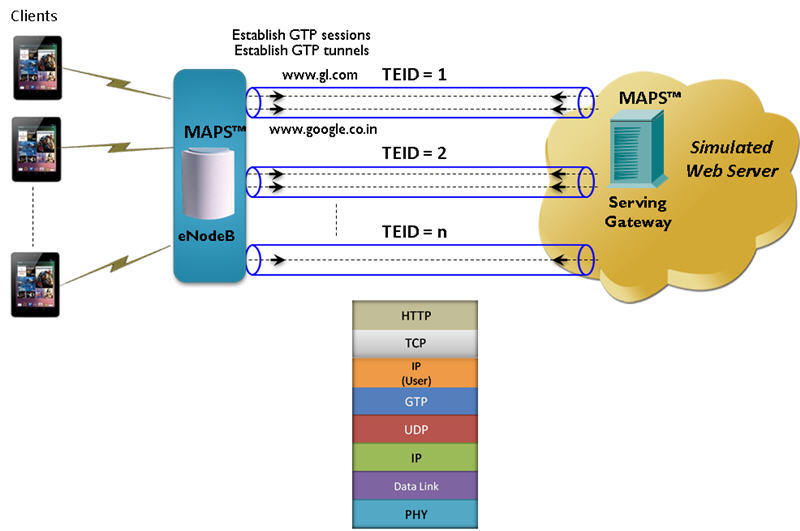
HD Mobile Traffic Core - GTPGL’s MAPS™ platform with PacketLoad™ appliance provides high density (up to 4 Gbps) stateful TCP/HTTP, UDP, and PCAP Replay traffic simulation solution in UMTS (SGSN, GGSN, RNC), and LTE (SGW, PDNGW) networks. PacketLoad™ is a 1U network appliance that includes 4 x 1GigE ports supporting total capacity of up to 4 Gbits/sec stateful packet traffic generation.  PacketLoad™ is available in following platform variants-  PacketLoad™ 4 x 10Gbps (PKS174) - Data Traffic Generator 2U Rack Appliance with 4 x 10Gbps NIC interfaces: total capacity of up to 40 Gbits/sec Stateful TCP/HTTP Traffic 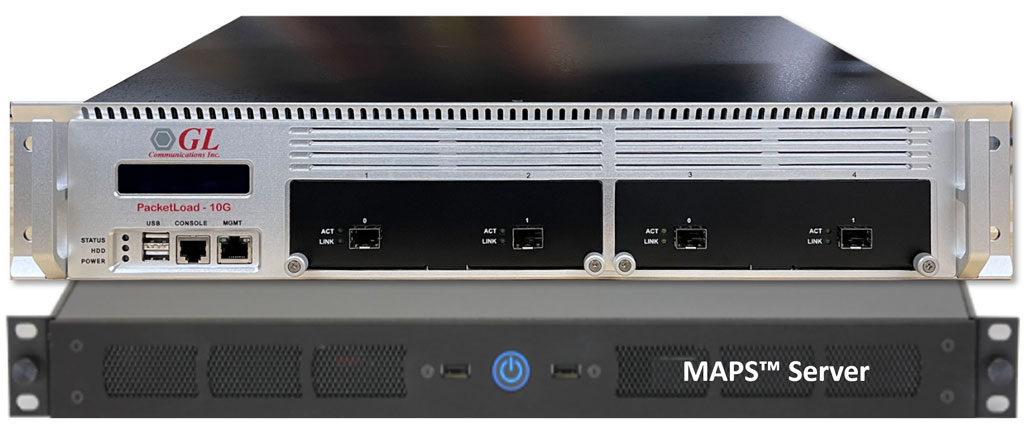 It allows simultaneous simulation of multiple sessions per user. Currently, PacketLoad™ supports HTTP traffic simulation with the base requirements such as port number, server IP address, and pre-canned HTTP traffic file. To verify bearer allocation bandwidth at the end points, the packet traffic can be generated with GL’s MAPS™ UMTS / LTE simulators along with PacketLoad™ module that allow to encapsulate the generated packet data within GTP headers and transmit through the gateway points such as SGSN & GGSN, or SGW & PGW. At the other end, MAPS™ with PacketLoad™ is used to verify the received data with the various statistics like Total packets transmitted and received, Latency, Delay, Bandwidth, No. of TCP connection created, Successful connection, Packet loss, and so on. Call Graph uses the results from statistics to plot graphically the Bandwidth on each port, HTTP_latency, TCP_Latency, and UE related statistics in form Bar/Line/Pie charts.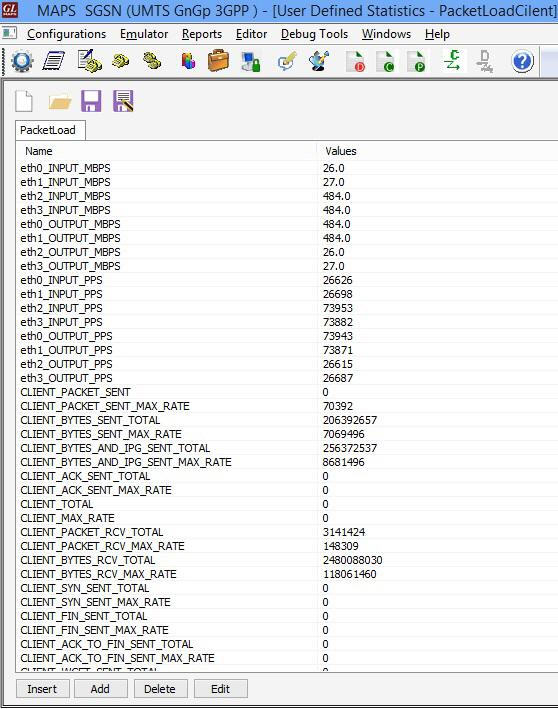 At the other end, MAPS™ with PacketLoad™ is used to verify the received data with the various statistics like Total packets transmitted and received, Latency, Delay, Bandwidth, No of TCP connection created, Successful connection, Packet loss, and so on. 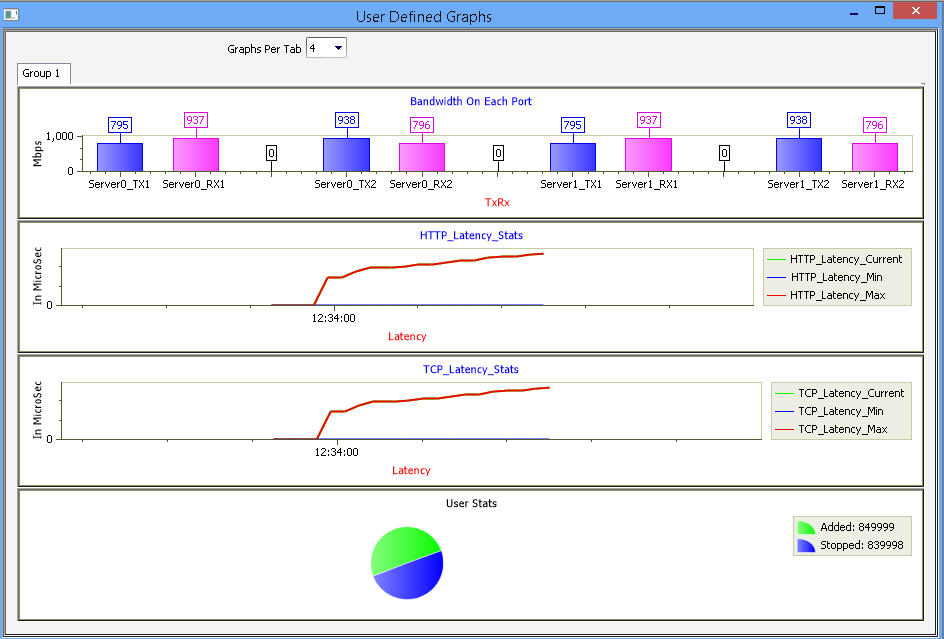 |
Mobile Traffic Core - Gateway (ETH102)
Mobile Traffic Core - Gateway module allows simulation of Gateway and transfer user plane data from RNC to GGSN. It handles GTP tunnels on both direction of SGSN. It can also act as GGSN for user-plane traffic by encapsulating IP traffic over GTP. This module is supported in MAPS™ GnGp, MAPS™ LTE S1, MAPS™ LTE eGTP-c
Mobile Traffic Simulation - GPRS Gb (ETH103)
Mobile Traffic Simulation - GPRS Gb Module allows simulation of Mobile traffic over Gb interface between BSC and SGSN. Currently, this module transmits the pre-canned HTTP file (*.txt) between BSC and SGSN nodes. It multiplexes both signaling and traffic over Gb interface. This module is supported in MAPS™ GPRS Gb.
Traffic Simulation - CLI
In addition to the GUI, all the traffic simulation action within MAPS™ can be automated and controlled remotely through a Command Line Interface (CLI). All of the GUI based functionalities are available in CLI. Supported clients include C++, TCL, Python and others.
Traffic simulation on a local network as well as from a remote location is possible with the client interface.
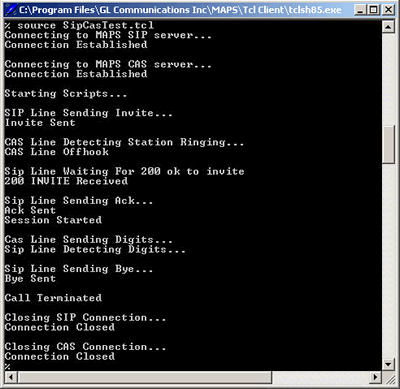
Traffic Simulation between IP to TDM
Resources
Note: PCs which include GL hardware/software require Intel or AMD processors for compliance.
Please Note: The XX in the Item No. refers to the hardware platform, listed at the bottom of the Buyer's Guide, which the software will be running on. Therefore, XX can either be ETA or EEA (Octal/Quad Boards), PTA or PEA (tProbe Units), XUT or XUE (Dual PCIe Express) depending upon the hardware.
